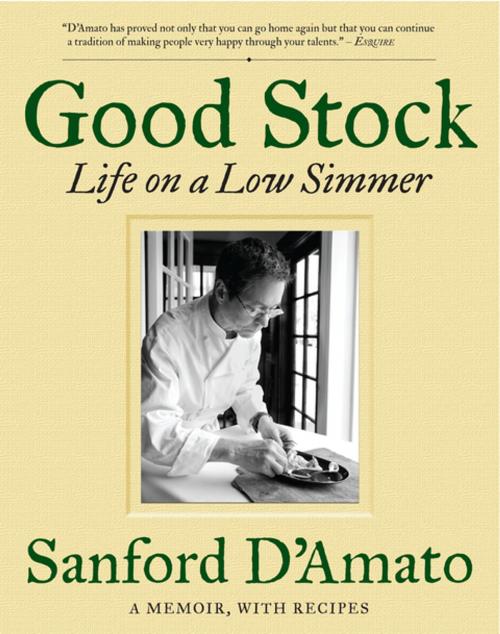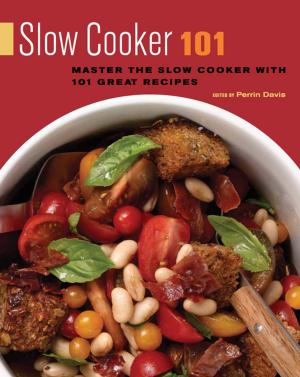Good Stock
Life on a Low Simmer
Nonfiction, Travel, Lodging & Restaurant Guides, Restaurants, Food & Drink, International, USA, Biography & Memoir| Author: | Sanford D'Amato | ISBN: | 9781572847286 |
| Publisher: | Agate Publishing | Publication: | October 21, 2013 |
| Imprint: | Agate Midway | Language: | English |
| Author: | Sanford D'Amato |
| ISBN: | 9781572847286 |
| Publisher: | Agate Publishing |
| Publication: | October 21, 2013 |
| Imprint: | Agate Midway |
| Language: | English |
Good Stock is the story of Sanford "Sandy" D'Amato's journey from young Italian kid who loved to cook to unknown culinary student with a passion for classical French cuisine to one of the most respected chefs and restaurateurs in the country. Featuring more than 80 recipes and full-color photography throughout, Good Stock weaves together memoir and cookbook in an beautiful and engaging package.
Sanford, the restaurant D'Amato opened in 1989 and sold to his longtime chef de cuisine in December 2012, has been one of the highest-rated restaurants in America over the past 20 years, earning accolades from Bon Appétit, Gourmet, Food & Wine, Esquire, Wine Spectator, Zagat Guide, and the James Beard Foundation. D'Amato has cooked for the Dalai Lama and the 2002 Salt Lake City Olympics, and was one of 12 chefs chosen by Julia Child herself to cook for her 80th birthday celebration. The story of Sanford and Sandy D'Amato is in part the story of America's embrace of fine dining and its acceptance of chefs as master craftsmen.
Over the past quarter century, America has seen a rise in the prominence of "celebrity chefs," to the extent that it's difficult to remember a time when becoming a chef was considered a backup plan more than a craft. That transformation began in the 1970s, right around when Sanford D'Amato was studying at the fabled Culinary Institute of America. This was a time when American cooks were by and large being frozen out by French chefs who didn't believe the Americans had what it took to create great cuisine. D'Amato, through persistence, skill, and the help of his mentor, Chef Peter Von Erp, became the first American cook at Le Veau d'Or and worked under Chef Roland Chenus through the groundbreaking opening of Le Chantilly. Soon the heyday of classic French cuisine began to waned, as rising chefs like D'Amato began leading the spread "New American" dining.
To D'Amato, though, the Midwest always signified home. His culinary inventiveness was inspired in part by his childhood home, located above his grandparents' grocery store on the lower east side of Milwaukee. It was a small apartment constantly filled with the sights of carefully prepared delicacies, the smells of rich foods on the simmer, and the many tastes of generations-old Italian recipes. Drawing on this influence, as well as his rigorous training in classic French technique, D'Amato eventually opened Sanford in the same space his grandparents' grocery store occupied.
In telling his story, D'Amato studs his narrative with 80 of his favorite recipes. The book features both personal photos from his background and career as well as beautiful images of finished recipes.
Readers of Good Stock will come to believe, as D'Amato does, that to create great food, it doesn't matter if you're preparing a grilled hot dog or pan-roasted monkfish-- what matters is that you treat all dishes with equal love, soul, and respect, and try to elevate each dish to its ultimate level of flavor. Good Stock combines Midwestern charm with international appeal as the perfect book for aspiring chefs, culinary students, and foodies everywhere.
Sanford, the restaurant D'Amato opened in 1989 and sold to his longtime chef de cuisine in December 2012, has been one of the highest-rated restaurants in America over the past 20 years, earning accolades from Bon Appétit, Gourmet, Food & Wine, Esquire, Wine Spectator, Zagat Guide, and the James Beard Foundation. D'Amato has cooked for the Dalai Lama and the 2002 Salt Lake City Olympics, and was one of 12 chefs chosen by Julia Child herself to cook for her 80th birthday celebration. The story of Sanford and Sandy D'Amato is in part the story of America's embrace of fine dining and its acceptance of chefs as master craftsmen.
Over the past quarter century, America has seen a rise in the prominence of "celebrity chefs," to the extent that it's difficult to remember a time when becoming a chef was considered a backup plan more than a craft. That transformation began in the 1970s, right around when Sanford D'Amato was studying at the fabled Culinary Institute of America. This was a time when American cooks were by and large being frozen out by French chefs who didn't believe the Americans had what it took to create great cuisine. D'Amato, through persistence, skill, and the help of his mentor, Chef Peter Von Erp, became the first American cook at Le Veau d'Or and worked under Chef Roland Chenus through the groundbreaking opening of Le Chantilly. Soon the heyday of classic French cuisine began to waned, as rising chefs like D'Amato began leading the spread "New American" dining.
To D'Amato, though, the Midwest always signified home. His culinary inventiveness was inspired in part by his childhood home, located above his grandparents' grocery store on the lower east side of Milwaukee. It was a small apartment constantly filled with the sights of carefully prepared delicacies, the smells of rich foods on the simmer, and the many tastes of generations-old Italian recipes. Drawing on this influence, as well as his rigorous training in classic French technique, D'Amato eventually opened Sanford in the same space his grandparents' grocery store occupied.
In telling his story, D'Amato studs his narrative with 80 of his favorite recipes. The book features both personal photos from his background and career as well as beautiful images of finished recipes.
Readers of Good Stock will come to believe, as D'Amato does, that to create great food, it doesn't matter if you're preparing a grilled hot dog or pan-roasted monkfish-- what matters is that you treat all dishes with equal love, soul, and respect, and try to elevate each dish to its ultimate level of flavor. Good Stock combines Midwestern charm with international appeal as the perfect book for aspiring chefs, culinary students, and foodies everywhere.
Good Stock is the story of Sanford "Sandy" D'Amato's journey from young Italian kid who loved to cook to unknown culinary student with a passion for classical French cuisine to one of the most respected chefs and restaurateurs in the country. Featuring more than 80 recipes and full-color photography throughout, Good Stock weaves together memoir and cookbook in an beautiful and engaging package.
Sanford, the restaurant D'Amato opened in 1989 and sold to his longtime chef de cuisine in December 2012, has been one of the highest-rated restaurants in America over the past 20 years, earning accolades from Bon Appétit, Gourmet, Food & Wine, Esquire, Wine Spectator, Zagat Guide, and the James Beard Foundation. D'Amato has cooked for the Dalai Lama and the 2002 Salt Lake City Olympics, and was one of 12 chefs chosen by Julia Child herself to cook for her 80th birthday celebration. The story of Sanford and Sandy D'Amato is in part the story of America's embrace of fine dining and its acceptance of chefs as master craftsmen.
Over the past quarter century, America has seen a rise in the prominence of "celebrity chefs," to the extent that it's difficult to remember a time when becoming a chef was considered a backup plan more than a craft. That transformation began in the 1970s, right around when Sanford D'Amato was studying at the fabled Culinary Institute of America. This was a time when American cooks were by and large being frozen out by French chefs who didn't believe the Americans had what it took to create great cuisine. D'Amato, through persistence, skill, and the help of his mentor, Chef Peter Von Erp, became the first American cook at Le Veau d'Or and worked under Chef Roland Chenus through the groundbreaking opening of Le Chantilly. Soon the heyday of classic French cuisine began to waned, as rising chefs like D'Amato began leading the spread "New American" dining.
To D'Amato, though, the Midwest always signified home. His culinary inventiveness was inspired in part by his childhood home, located above his grandparents' grocery store on the lower east side of Milwaukee. It was a small apartment constantly filled with the sights of carefully prepared delicacies, the smells of rich foods on the simmer, and the many tastes of generations-old Italian recipes. Drawing on this influence, as well as his rigorous training in classic French technique, D'Amato eventually opened Sanford in the same space his grandparents' grocery store occupied.
In telling his story, D'Amato studs his narrative with 80 of his favorite recipes. The book features both personal photos from his background and career as well as beautiful images of finished recipes.
Readers of Good Stock will come to believe, as D'Amato does, that to create great food, it doesn't matter if you're preparing a grilled hot dog or pan-roasted monkfish-- what matters is that you treat all dishes with equal love, soul, and respect, and try to elevate each dish to its ultimate level of flavor. Good Stock combines Midwestern charm with international appeal as the perfect book for aspiring chefs, culinary students, and foodies everywhere.
Sanford, the restaurant D'Amato opened in 1989 and sold to his longtime chef de cuisine in December 2012, has been one of the highest-rated restaurants in America over the past 20 years, earning accolades from Bon Appétit, Gourmet, Food & Wine, Esquire, Wine Spectator, Zagat Guide, and the James Beard Foundation. D'Amato has cooked for the Dalai Lama and the 2002 Salt Lake City Olympics, and was one of 12 chefs chosen by Julia Child herself to cook for her 80th birthday celebration. The story of Sanford and Sandy D'Amato is in part the story of America's embrace of fine dining and its acceptance of chefs as master craftsmen.
Over the past quarter century, America has seen a rise in the prominence of "celebrity chefs," to the extent that it's difficult to remember a time when becoming a chef was considered a backup plan more than a craft. That transformation began in the 1970s, right around when Sanford D'Amato was studying at the fabled Culinary Institute of America. This was a time when American cooks were by and large being frozen out by French chefs who didn't believe the Americans had what it took to create great cuisine. D'Amato, through persistence, skill, and the help of his mentor, Chef Peter Von Erp, became the first American cook at Le Veau d'Or and worked under Chef Roland Chenus through the groundbreaking opening of Le Chantilly. Soon the heyday of classic French cuisine began to waned, as rising chefs like D'Amato began leading the spread "New American" dining.
To D'Amato, though, the Midwest always signified home. His culinary inventiveness was inspired in part by his childhood home, located above his grandparents' grocery store on the lower east side of Milwaukee. It was a small apartment constantly filled with the sights of carefully prepared delicacies, the smells of rich foods on the simmer, and the many tastes of generations-old Italian recipes. Drawing on this influence, as well as his rigorous training in classic French technique, D'Amato eventually opened Sanford in the same space his grandparents' grocery store occupied.
In telling his story, D'Amato studs his narrative with 80 of his favorite recipes. The book features both personal photos from his background and career as well as beautiful images of finished recipes.
Readers of Good Stock will come to believe, as D'Amato does, that to create great food, it doesn't matter if you're preparing a grilled hot dog or pan-roasted monkfish-- what matters is that you treat all dishes with equal love, soul, and respect, and try to elevate each dish to its ultimate level of flavor. Good Stock combines Midwestern charm with international appeal as the perfect book for aspiring chefs, culinary students, and foodies everywhere.















